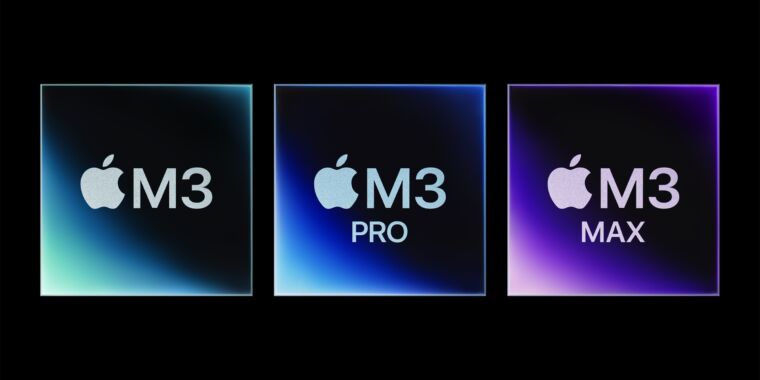Apple introduces new M3 chip lineup, starting with the M3, M3 Pro, and M3 Max – Ars Technica
Front page layout
Site theme
Andrew Cunningham – Updated
NEW YORK—None of the new Macs that Apple is announcing at its “Scary Fast” product event today look very different from the ones they’re replacing on the outside, but the inside is another story. This is the first batch of Macs to include Apple’s next-generation M3-series chips, and unlike past years, Apple is introducing multiple M3 performance tiers all at the same time.
The M3, M3 Pro, and M3 Max all share the same underlying CPU and GPU architectures, the same ones used in the iPhone 15 Pro’s A17 Pro chip. Also like the A17 Pro, all M3 chips are manufactured using a new 3 nm process from Taiwan Semiconductor (TSMC). Let’s dive into everything we know about the M3 family’s capabilities, plus the differences between each performance tier.
Apple says that the performance cores in any given M3 processor can run up to 30 percent faster than the M1’s performance cores, and that the efficiency cores are up to 50 percent faster. Most of Apple’s direct performance comparisons were to the M1 generation, which is useful insofar as M2 Mac owners aren’t likely to want to spring for M3, but it has the added marketing benefit of making the performance increases sound larger than they are.
To put those numbers in context, the M2’s P-cores were already between 10 and 20 percent faster than the M1’s, depending on the chip. Isolating the E-cores in benchmarks is a bit more difficult, but Apple says that the M3 is up to 35 percent faster than the M1 at peak power. Apple said the M2 was about 18 percent faster than M1.
The M3’s GPU is also based on the same architecture as the A17 Pro, which means that all M3 Macs are picking up hardware-accelerated ray-tracing support like what you find in more recent Nvidia GeForce and AMD Radeon GPUs. As in desktop PCs, enabling ray tracing in most games and apps is going to come with a performance penalty, which may make it more usable on the M3 Pro and Max than it is in the basic M3, but every GPU in the family at least supports the capability.
Other hardware features added to the M3 GPU include “Dynamic Caching,” which claims to allocate “only the exact amount of memory needed… for a given task,” allowing more tasks to utilize the GPU at a given time. Like DirectX 12 Ultimate GPUs, the M3 GPU also supports hardware-accelerated mesh shading, useful for rendering scenes that use a whole lot of small objects.
Aside from new hardware features, Apple says that peak GPU performance for the M3 series is up to 65 percent faster than M1’s, though as with the CPU performance this will likely vary based on which chips you’re comparing. In our tests, the various M2-series GPUs are generally between 25 and 30 percent faster than their M1 equivalents, so the year-over-year performance increases from M1 to M2 to M3 are fairly even. Apple says that the M3’s rendering performance is up to 2.5 times faster than the M1 for workloads that take advantage of the new hardware acceleration features.
Finally, the media engine in the M3 series supports hardware-accelerated decoding for AV1 video streams. Newer PC GPUs also support hardware-accelerated encoding, but it’s still a fairly niche feature with relatively limited usefulness for home users beyond high-resolution video broadcasting. Still, it’s something that most modern integrated PC GPUs support (or will support very soon), so it’s too bad not to see it here.
Join the Ars Orbital Transmission mailing list to get weekly updates delivered to your inbox. Sign me up →
CNMN Collection
WIRED Media Group
© 2024 Condé Nast. All rights reserved. Use of and/or registration on any portion of this site constitutes acceptance of our User Agreement (updated 1/1/20) and Privacy Policy and Cookie Statement (updated 1/1/20) and Ars Technica Addendum (effective 8/21/2018). Ars may earn compensation on sales from links on this site. Read our affiliate link policy.
Your California Privacy Rights |  Do Not Sell My Personal Information
Do Not Sell My Personal Information
The material on this site may not be reproduced, distributed, transmitted, cached or otherwise used, except with the prior written permission of Condé Nast.
Ad Choices

